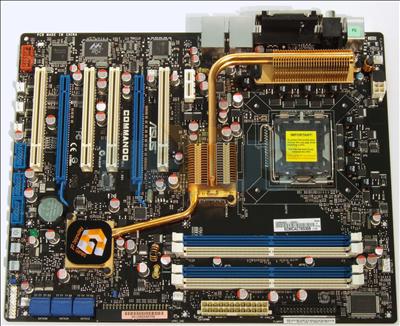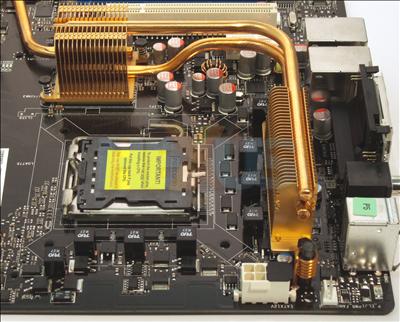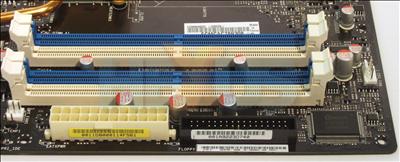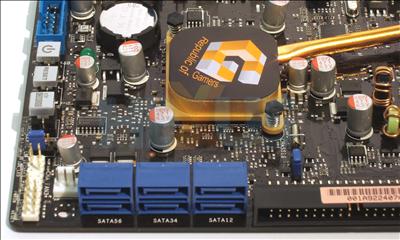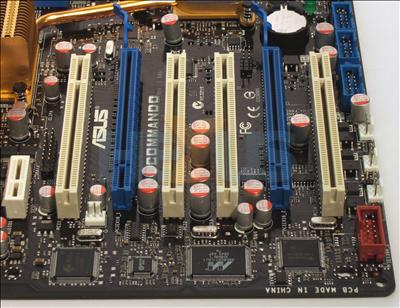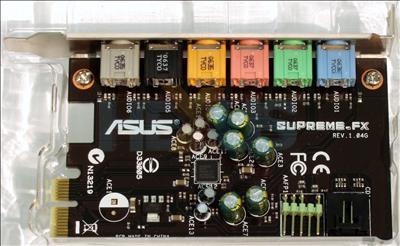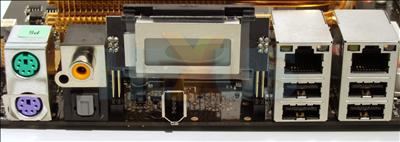Layout and features
The ASUS COMMANDO is part of the Republic Of Gamers (ROG) series. ROG motherboards are designed to push the performance envelope to the very limit whilst not skimping on features. Think of it as ASUS's premium boards with a healthy, extra dose of enthusiast-orientated options.The first ROG board was the ASUS CROSSHAIR, an AMD AM2 motherboard which brought hither-to unseen levels of tweaking from ASUS BIOSes. Now, the ROG design ethos has been brought over to Intel's Core 2 Duo processors with the STRIKER and COMMANDO models (note the flagrant use of caps).
ASUS has managed the rare trick of loading a motherboard with features yet kept the layout simple and clean.
A closer look at the CPU area highlights the amount of room around the LGA775 socket, making it easy to install larger heatsinks or watercooling blocks.
Winding its way around to this side of the board, ASUS adopts the tried-and-trusted heatpipe cooling approach, designed to keep the northbridge and voltage-regulation components operating at decent temperatures. It also has the benefit of making this enthusiast-class board a zero-noise model.
Further, ASUS uses digital PWM to deliver smooth, well-regulated voltage to the CPU.
The main 24-pin power and floppy ports are well-situated down one side of the COMMANDO. There are three fan headers in close proximity to the CPU and two are shown in the above picture.
We appreciate the fact that you can install system RAM without having to tinker with removing a long graphics card. That's due to the clever, sensible layout of the expansion ports.
As with most other boards of this ilk, the COMMANDO supports 4 DIMM slots that offer dual-channel memory operation by pairing up modules in the same-coloured slots. Jumping ahead a little, the BIOS supports memory speeds of up to 1067MHz out of the box, further underscoring the COMMANDO's enthusiast pedigree.
To the right you can see the single ATA port - run off a JMicron controller due to the ICH8R's lack of PATA support - next to a sextet of SATA2 ports that are run off the heatpipe-clad southbridge. The rotated design is a nice touch but the location - near the bottom of the board - may cause problems with folks who have large chassis. The JMicron JMB363 controller appears to be a good fit on first glance, but ASUS has decided not to utilise its built-in 2 SATA2 ports. Further, the controller has limited support outside of a Windows environment, such that imaging programs that require booting into DOS may not recognise the controller and any connected drives.
ASUS hasn't forgotten the enthusiast's friend: the COMMANDO has board-mounted on/off buttons which match the clear CMOS' design. No more silly fiddling with tiny jumpers and cursing when it disappears into the dark recesses of the chassis.
By situating a conventional PCI slot above the main x16 PCIe's, ASUS improves upon regular layouts by allowing you to use at least two PCIc slots even if both PCIes are populated by double-width cards.
Note, however, that the right-hand x16 mechanical slot runs at a maximum of x4, meaning that it is still suitable for CrossFire multi-GPU usage but you may run into bandwidth issues with high-end cards.
The small, white slot on the left of the above picture is for the ASUS SupremeFX audio card, and you can see it below.
The COMMANDO features ADI's impressive AD1988B audio CODEC that's run in conjunction with the high-def audio emanating from the ICH8R southbridge. It supports DTS Connect, which converts any stereo source into DTS surround audio, and by ASUS housing the ports on a discrete card, it opens up the way to add something special on the I/O section.
Regular fare out of the way first. Digital audio support is in the form of both coaxial and optical S/PDIF outputs. Only 4 rear-mounted USB2.0 ports dictates that you will need to use your chassis' and/or add in further support via supplied brackets that block off an expansion slot.
But what's that in the middle, right above the single FireWire400 port? It's an LCD Poster that improves on the usual debug LEDs by displaying the name of each boot process rather than a two-digit number. It's a nice touch but would have been better suited if located in a module that mounted in, say, a 3.5in chassis.
Summary
ASUS has most of the bases covered as far as layout and features are concerned. There's been genuine thought on how to make installation easy whilst maintaining a decent feature-set. Enthusiasts will appreciate the LCD Poster (although not its location) and the board's 7 fans - in addition to the CPU's - are great.The COMMANDO is a well-featured board but still does without FireWire800 and integrated WiFi support.
NVIDIA raised the bar with the layout of its nForce 680i SLI motherboard: ASUS has, in our opinion, matched it with its P965-based COMMANDO.
Priced at around £140 the COMMANDO needs to support multi-GPU CrossFire technology and it does, albeit with the second mechanical x16 slot only capable of running at x4 electrically. We'll show you how that impacts on performance a little later on.






